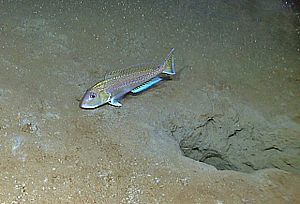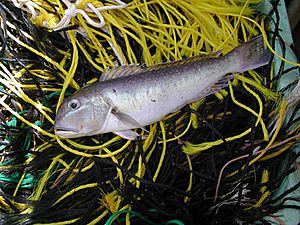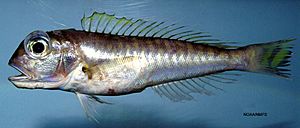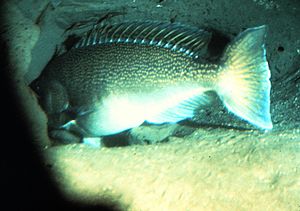Great northern tilefish facts for kids
Quick facts for kids Great northern tilefish |
|
|---|---|
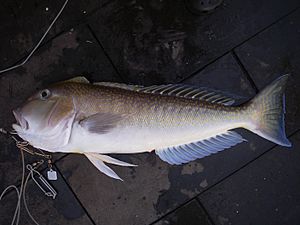 |
|
| Conservation status | |
| Scientific classification | |
| Kingdom: | |
| Phylum: | |
| Class: | |
| Order: | |
| Suborder: |
Percoidea
|
| Family: |
Malacanthidae
|
| Genus: |
Lopholatilus
|
| Species: |
L. chamaeleonticeps
|
| Binomial name | |
| Lopholatilus chamaeleonticeps Goode & T. H. Bean, 1879
|
|
The great northern tilefish, also called the golden tile, is a large fish. It's the biggest kind of tilefish, growing up to 38 to 44 inches (970 to 1,120 mm) long. These fish grow slowly and live for a long time. They go through four main life stages.
First, they hatch from tiny eggs as larvae. These larvae float around in the ocean's plankton. As they get older, they become juveniles and look for safe places to hide. They might find a burrow or dig their own. When they become adults, they keep making their burrows bigger in the sand or mud on the seafloor.
Young tilefish probably eat tiny floating animals called zooplankton. Older tilefish, both juveniles and adults, eat many different creatures that live on the ocean bottom. This includes invertebrates like crabs and lobster, and even other small fish.
Female tilefish start laying eggs when they are about 5 to 7 years old. They lay eggs many times during the mating season. Each female can lay millions of eggs for the male to fertilize.
People have rules about fishing for great northern tilefish. These rules help stop too many fish from being caught. They include limits on how many fish can be caught and what kind of fishing gear can be used. These rules also help protect the fish's home. Because of these rules, the number of tilefish has grown. This led to more fish being allowed to be caught in 2012 along the southern Atlantic coast.
Contents
About the Great Northern Tilefish
Discovery and Name Origins
Scientists first found the great northern tilefish in 1879. A cod trawler (a type of fishing boat) accidentally caught some of these fish. This happened while the boat was fishing off the coast of Massachusetts.
The fish got its scientific name, Lopholatilus chamaeleonticeps, in 1896. George Brown Goode and Tarleton Hoffman Bean gave it this name. They wrote about it in their important book about deep-sea fish. The fish they studied came from about 80 miles (130 km) southeast of Nomans Land, Massachusetts.
The great northern tilefish is part of the Lopholatilus group. This group belongs to the Malacanthidae family, which are all called tilefish. The name "great northern tilefish" comes from its large size. It was also found further north than other tilefish. When cooked, people often call it "golden tile." This is because it has bright yellow spots on its blue-green back. Its sides are lighter yellow or pink. A special crest on its head helps tell it apart from other tilefish.
What Does a Tilefish Look Like?
The great northern tilefish is the biggest fish in the tilefish family. Male fish can grow up to 112 cm (44 in) long. Females can reach 100 cm (39 in) in length. For their first four years, they grow about 10cm/yr each year. After that, they grow more slowly. They are ready to have babies when they are between 50 and 70 cm (20 and 28 in) long. Most adult tilefish live for 25 to 35 years.
The back of the fish shines with blue-green colors and has many yellow and gold spots. Its belly is white. During the time they lay eggs, the color of their head changes. It goes from light blue to a mix of pink. They have a blue color under their eyes. Their side fins are light brown. The edge of their anal fin is a purplish-blue.
Male tilefish usually grow faster and get bigger than females. However, females often live longer. The biggest male found was 44.1 in (1,120 mm) long and about 20 years old. The oldest female found was 39 years old and 40.2 in (1,020 mm) long. The oldest tilefish ever recorded was a 46-year-old female. She was 33.5 in (850 mm) long. The oldest male recorded was 41.3 in (1,050 mm) long and 29 years old.
Tilefish Behavior and Life Cycle
The great northern tilefish is known for digging and living in burrows. Males usually grow larger than females and are more dominant. These fish do not travel far. They stay in one area all year long if it meets their needs. Some people think they might move a little when water temperatures change in winter or spring. But there is no strong proof of this. Another idea is that they might just slow down or "hibernate" in their burrows when it gets cold.
Life Cycle
The life of a great northern tilefish starts as a floating egg. If eggs are fertilized and kept warm (between 71 and 76 °F (22 and 24 °C)), they hatch in about 40 hours. The tiny larvae that hatch are only about 0.1 in (2.5 mm) long. You can find these larvae floating in the ocean's plankton from July to September.
Scientists don't know much about the stage between larvae and young fish (juveniles). But juveniles either find a burrow or dig one to live in. Once they grow bigger and can have babies, the adult fish lay eggs during the mating season. This helps make sure more tilefish are born.
Burrowing Behavior
Scientists are still studying how tilefish build and expand their burrows. It's not clear if they start a new burrow or just make an old one bigger. It's thought that the fish makes its burrow longer and wider as it grows older.
Tilefish usually live in their own burrows. But sometimes a male and female pair might share one. Tilefish tend to live close to each other, with their burrows near one another. However, they do not swim together in large groups called schools. In some areas, there can be as many as 13,000 burrows in one square kilometer! These burrows also provide homes for other ocean creatures, like mollusks and crabs.
What Do Tilefish Eat?
Scientists are not sure what tilefish larvae eat, but they think it's tiny floating animals called zooplankton. Young tilefish and adults eat many different small creatures that live on the ocean bottom. They especially like crabs and lobster. They also eat clams and oysters, salps, squid, and some other fish like dogfish, mackerel, and herring. Sometimes, they even eat human trash like potato peels or meat bones. They have also been known to eat other tilefish.
Who Eats Tilefish?
Not much is known about what animals hunt tilefish. Young tilefish might be eaten by dogfish or conger eels. Interestingly, adult tilefish sometimes eat these same eels! Sharks are thought to be predators, but there's no clear proof of sharks attacking free-swimming tilefish. The only known predator of the tilefish is the goosefish. It was once thought that tilefish burrows were mainly for hiding from predators. But now, some scientists think that chased tilefish try to swim away instead of going into their burrows.
Reproduction of Tilefish
Great northern tilefish lay eggs from early spring to late fall, usually from March to November. The busiest time for laying eggs is from May to September. Water temperature changes can affect when they breed. In warmer waters further south, they lay eggs from April to June.
Male tilefish grow faster and get bigger than females. If there's a lot of fishing, males might start having babies when they are smaller and younger.
Scientists don't know exactly how tilefish mate. But it's thought that one male might mate with several females. It seems that male and female pairs sometimes stay together. This might help make sure the eggs get fertilized. It's estimated that a female can lay eggs about every four days, up to 34 times in one season. Depending on her size, an average female can lay between 195,000 and 8 million eggs in a season. The average is about 2.3 million eggs.
Because of too much fishing in the past, the age at which tilefish can have babies has changed a lot. From 1978 to 1982, male tilefish started having babies much younger. The average age dropped from 7.1 years to 4.6 years. This meant males were ready to reproduce before females. By 2008, the average age for males to reproduce had gone up to 5.9 years. Female tilefish don't have many babies when they first become mature. They have more as they get older. Their age for having babies has not changed as much as the males'.
Where Tilefish Live
You can find great northern tilefish in the Atlantic Ocean waters near the United States. They live from the Nantucket Shoals and Georges Bank in the north, all the way down the East Coast, and into the Gulf of Mexico. They live along the edge of the continental shelf.
These fish are most common in water between 300 and 480 feet (91 and 146 m) deep. The water temperature there is usually around 76 °F (24 °C). However, another report says they live on the ocean bottom, digging into the mud, at depths between 250 and 1,500 feet (76 and 457 m). In these deeper areas, the water temperature ranges from 49 to 58 °F (9 to 14 °C).
Great northern tilefish are known for digging and living in burrows. They make these homes on the outer continental shelf and near deep underwater canyons. They prefer soft clay ground because it's easy to dig. Because they live a long time, grow slowly, and have special mating habits, they can be easily overfished. They can also die in large numbers if the water gets too cold. Their numbers are highest where there is soft, silty clay. This is because the soft clay lets them dig their burrows easily. The coldest temperature they can handle is about 9 °C (48 °F).
Tilefish Population and Protection
The age and size at which great northern tilefish become adults are changing. In the Mid-Atlantic Bight, fish were smaller and younger when they became adults in 2008. This was different from the 1980s, when the fish were larger. Recent studies in the southern U.S. waters also showed smaller and younger fish. Also, very few young tilefish were seen in surveys in the southern U.S. Atlantic Ocean and the Gulf of Mexico.
If the number of tilefish keeps going down, it could hurt other creatures. This is because other animals use the tilefish burrows for shelter. Without the tilefish, these burrows would disappear. This would end the helpful relationship (called symbiotic) that other animals have with the burrows.
Fishing rules are in place to help protect tilefish. These rules include limits on how many fish can be caught. They also have rules about fishing gear to avoid harming the fish's home. In 2007, rules were made to cut down fishing by one-third. This was to help the fish population in the South Atlantic. Later, in October 2012, the catch limit for the South Atlantic was increased. This happened because the number of fish had grown.
In 2013, the limits for catching tilefish in the southern U.S. Atlantic waters were:
- 405,971 pounds for longline fishing (a method using a very long line with many hooks)
- 135,324 pounds for hook-and-line fishing (a more traditional method)
As of 2019, the current South Atlantic catch limits are:
- 248,805 pounds for longline fishing
- 82,935 pounds for hook-and-line fishing



